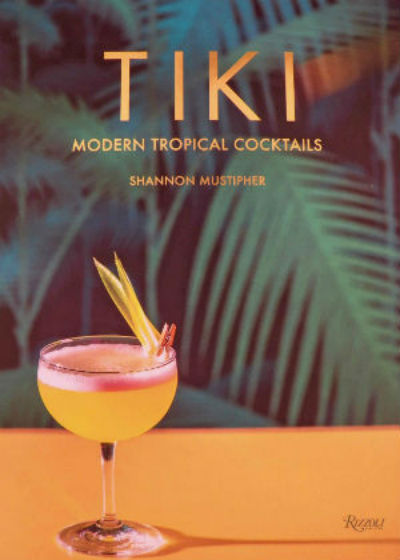A celebration of Caribbean rums, Tiki: Modern Tropical Cocktails by Shannon Mustipher, explores the flavours, unique characteristics, and personalities of sugar cane-based spirits and reveals the secrets to making creative drinks your guests will always remember.
 Embellished with lavish colourful pictures, readers are inspired to create the artfully presented tipples that grace the pages of this 192-page hardcover book. Indeed, crafting drinks as an art form is the thread that unifies this publication.
Embellished with lavish colourful pictures, readers are inspired to create the artfully presented tipples that grace the pages of this 192-page hardcover book. Indeed, crafting drinks as an art form is the thread that unifies this publication.
From the very first chapter we are introduced to the ‘Theatre of the Senses’ where Mustipher emphasises that “mixing a fantastic cocktail requires a balance of art and science…” It is this balancing of the right ingredients, flavours, and technique that transforms the cocktail into something special, stimulating the senses into a unique sensory experience, the mixologist says. And, it is with these guidelines that readers begin.
From simple to elaborate, Tiki cocktails started around the 1930s with growing curiosity and interest in exotic tropical cultures. Mustipher shows you the secrets to blending rums with sakes, mezcals, and even vodka to create signature drinks with explosive finishes. But, she warns, the best cocktails must start with fresh ingredients, and nuff imagination.
Behind the Recipe
What makes Tiki different from other cocktail tomes is the history lessons behind the recipes. Did you know that by 1750 the British Navy had become the largest rum consumers in the world? This is an interesting fact readers gain as the author explains the characteristics of the various style rums. English-style rums, for example, were crafted in the former British colonies including Barbados, Guyana, Trinidad and Tobago, St. Lucia, and Jamaica and are known for their bold flavours. French-style rums (known as Rhums in francophone counties) on the other hand are characterised by their vegetal and grassy notes while Spanish rums (from Cuba) are enjoyed for their dry, crisp taste.
Of course, readers also learn the rum lingo, necessary to be able to choose the right rum base, mix, and create unique drinks. Perhaps two of the most important elements to master is the Alcohol by Volume (ABV) and the Ageing process. Depending on your event, drinkers, and time of day, ABV will be critical. After all, serving overproof rum which contains more esters and is more intense than other styles probably wouldn’t be wise at a day party. The age of the rum and fermentation too will determine its strength and the all important notes it picks up from the container it was aged in — oak barrel, other types of wood, or stainless steel.
Once you’ve determined the kind of rum you will use, the other ingredients better be high quality. Even the ice must be considered—another tidbit learned from Mustipher. Ice can be either a coolant or act as a diluting element, it all depends on the size (cubed, crushed, nugget, shaved) Who wudda thunk it? And something many of us don’t think of: ice picks up the flavours in your freezer. So, please don’t use ice that’s been sitting next to garlic or fish!
Unexpected
Creating the right atmosphere is also part and parcel of crafting a fabulous rum cocktail. The bottom line is music is important. Mustipher notes that hosts can play music, as long as it comes from a “place that has palm trees”. She even lists chart toppers suggested by DJ compatriot, Brother Cleve. This is precious advice and quite unexpected in a book of cocktail-making.
The author doesn’t skimp when it comes to Tools of the Trade either. Proper tools, she points out, is a critical element in mixing great drinks. Investing in quality jiggers and measures, shakers, bar spoons, strainers, mixing glasses, pitchers, drinking glasses, etc is the mark of a thoughtful mixologist. Even something like a swizzle stick (used to stir your drink) is essential in creating a finished drink. Interestingly, we learn that these funny looking sticks are cut from a Caribbean evergreen tree (Quararibea turbinata), or the swizzle stick tree, which naturally produces spikey-looking sticks.
Wow, much more than a how-to book! Besides learning how to make remarkable Caribbean-inspired cocktails, Mustipher adds history, anecdotes, and fun.


